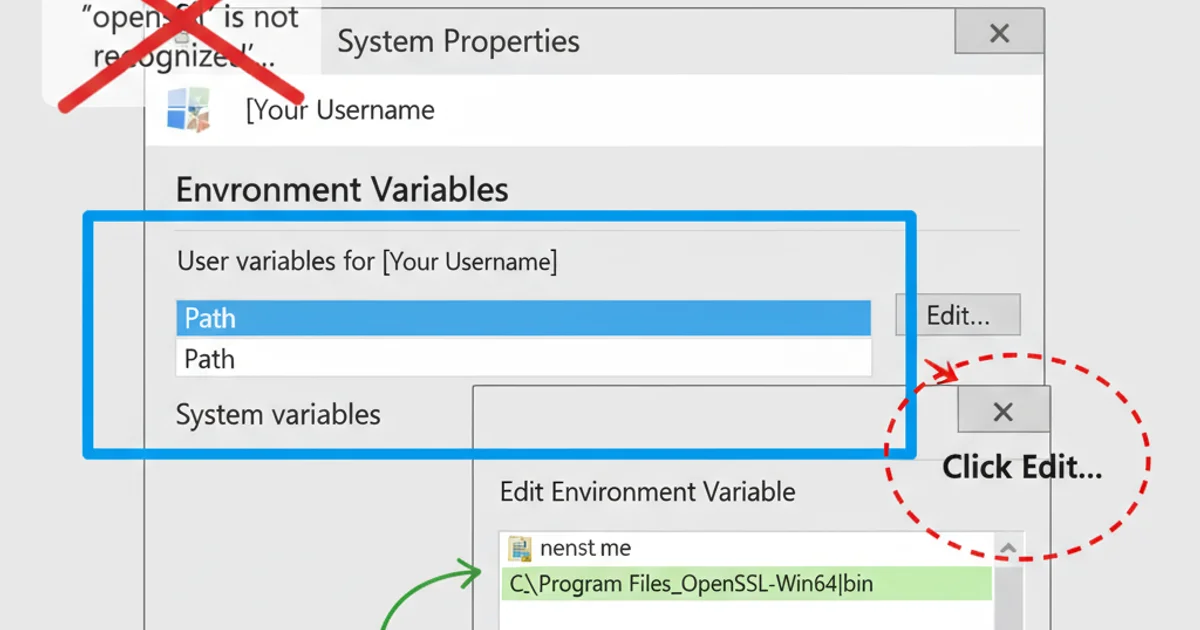'openssl' is not recognized as internal or external command
Categories:
Fixing 'openssl' Not Recognized on Windows

A comprehensive guide to resolving the 'openssl' command not found error in Windows Command Prompt or PowerShell, covering common causes and solutions.
Encountering the error message "'openssl' is not recognized as an internal or external command, operable program or batch file" is a common frustration for Windows users trying to utilize OpenSSL. This usually indicates that the system cannot locate the openssl.exe executable. This article will walk you through the primary reasons for this error and provide step-by-step solutions to get OpenSSL working correctly on your system.
Understanding the Problem: Why 'openssl' Isn't Found
The 'not recognized' error typically means one of two things: either OpenSSL is not installed on your system, or it is installed but its location is not included in your system's PATH environment variable. The PATH variable tells your operating system where to look for executable files when you type a command in the command prompt or PowerShell.
flowchart TD
A[User types 'openssl' in CMD/PowerShell]
B{Is 'openssl.exe' in current directory?}
C{Is OpenSSL directory in System PATH?}
D[Error: 'openssl' not recognized]
E[OpenSSL command executes successfully]
A --> B
B -- No --> C
B -- Yes --> E
C -- No --> D
C -- Yes --> EFlowchart illustrating how the system searches for the 'openssl' command
Solution 1: Installing OpenSSL on Windows
If you haven't installed OpenSSL yet, this is your first step. OpenSSL does not come pre-installed with Windows. You'll need to download a pre-compiled binary distribution, as compiling it from source can be complex. The most common and recommended distribution for Windows is from the OpenSSL for Windows project (often found via wiki.openssl.org/index.php/Binaries).
1. Download the Installer
Visit a reliable source for OpenSSL binaries, such as the OpenSSL for Windows project. Choose the appropriate version for your system (e.g., 64-bit or 32-bit) and download the .exe installer.
2. Run the Installer
Execute the downloaded .exe file. Follow the on-screen prompts. During installation, pay attention to the installation directory. A common default is C:\Program Files\OpenSSL-Win64 or C:\Program Files (x86)\OpenSSL-Win32.
3. Choose Installation Options
When prompted, select to install the OpenSSL DLLs to 'The Windows system directory' or 'The OpenSSL installation directory'. Installing to the system directory is often more convenient for system-wide access, but installing to the OpenSSL directory is also fine as long as you add it to PATH.
Solution 2: Adding OpenSSL to Your System PATH
Even after installation, if the installer didn't automatically add OpenSSL to your PATH, you'll need to do it manually. This is crucial for the command prompt to find openssl.exe.
1. Locate OpenSSL Installation Directory
Find where OpenSSL was installed. This is typically C:\Program Files\OpenSSL-Win64\bin or C:\Program Files (x86)\OpenSSL-Win32\bin. Make sure you navigate into the bin subdirectory where openssl.exe resides.
2. Open System Properties
Right-click on 'This PC' (or 'My Computer') and select 'Properties'. Alternatively, search for 'Environment Variables' in the Windows search bar and select 'Edit the system environment variables'.
3. Access Environment Variables
In the System Properties window, click on 'Advanced system settings', then click the 'Environment Variables...' button.
4. Edit the PATH Variable
Under 'System variables', find the variable named Path (case-insensitive) and select it. Click 'Edit...'.
In the 'Edit environment variable' window, click 'New' and paste the full path to your OpenSSL bin directory (e.g., C:\Program Files\OpenSSL-Win64\bin). Click 'OK' on all open windows to save the changes.
5. Verify Installation
Open a new Command Prompt or PowerShell window (existing ones won't have the updated PATH). Type openssl version. If successful, you should see the OpenSSL version information.
setx PATH "%PATH%;C:\Program Files\OpenSSL-Win64\bin"
Adding OpenSSL to PATH via command line (for current user, requires new terminal)
Troubleshooting Common Issues
If you're still facing issues, consider these points:
- Incorrect Path: Double-check the path you added to the environment variables. A typo or an incorrect directory will prevent the command from being found.
- Multiple OpenSSL Installations: If you have multiple versions of OpenSSL installed, ensure the correct one's
bindirectory is in your PATH, and that it's listed before any other conflicting paths. - Permissions: Ensure you have the necessary permissions to install software and modify system environment variables. You might need administrator privileges.
- Reboot: In rare cases, especially on older Windows versions, a system reboot might be necessary for PATH changes to take full effect.

Visual guide to adding OpenSSL to the system PATH environment variable.
By following these steps, you should successfully resolve the "'openssl' is not recognized" error and be able to use OpenSSL commands on your Windows system. Remember that proper installation and configuration of environment variables are key to seamless command-line tool usage.